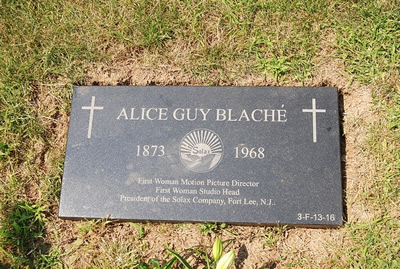Alice Guy Balché (1873-1968)
 Alice Guy Balché was one of a very few women who were successful in film production in the early years of movies. She directed, produced, or supervised about 1,000 films in a career that spanned the 1890s to the 1920s. Along with her husband, Herbert, she formed the Solax film company in 1910.
Alice Guy Balché was one of a very few women who were successful in film production in the early years of movies. She directed, produced, or supervised about 1,000 films in a career that spanned the 1890s to the 1920s. Along with her husband, Herbert, she formed the Solax film company in 1910.
Alice Guy had begun working as a secretary for movie camera producer Léon Gaumont. She convinced Gaumont to allow her to make short films that would be used to demonstrate his cameras. Her first was The Cabbage Fairy in 1896. Originally Gaumont just wanted films to demonstrate the camera but soon Guy became head of film production at his company and made several hundred short films.
There is an interesting controversy about The Cabbage Fairy. In describing the film, Guy Balché seems to suggest that it is a multi-shot narrative film. If that was true, the film was years ahead of its time. However, since the film was lost, and there were no corroborating accounts, there was no way of assessing the claim. Things got even more complicated when, in the 1990s, a short film that might be The Cabbage Fairy was discovered. You can see the film on YouTube. If that film is truly The Cabbage Fairy in its entirety, then Guy Balché's claim is false. It's a good but conventional minute long film, typical of its era: one shot, static camera. However, might there have been other shots that remain lost? Might The Cabbage Fairy be another film altogether? We don't know.
Anyhow, in 1907, Guy married Herbert Balché, another Gaumont employee and the couple soon moved to the US where Herbert became US production manager for Gaumont. Three years later, Alice Guy, Herbert Balché, and a third partner, George A. Magie joined to form Solax Studios, with Herbert as the production manager and Alice as most everything else. Solax created one of the first fully integrated film studios in Fort Lee, New Jersey (a NYC suburb).
Solax had a large stock company that included adult and child actors and a large animal menagerie that included a 600 pound tiger named Princess. Balché's films were in many ways highly innovative. For example, the 1912 film Two Little Rangers features two tween cowgirls who hunt down a wife-beating criminal and, using arrows and guns, eventually force him to jump off a cliff (you can see the film here). That same year, she made A Fool and His Money, which is believed to be the first film with an all black cast.
Through the 19-teens Solax continued to be successful, producing hundreds of movies, some of them feature length. Many of the Solax films were distributed by Metro (see the page on the studios and their heads). When Solax was not using the studio space, it was rented to other film makers as well. Things continued fairly well until 1918 when Herbert Balché left to pursue a career in Hollywood. In 1919, a fire destroyed much of Solax (you can actually see a movie of the fire here). Guy-Balché moved to Hollywood but did not reunite with Balché and she returned to France in 1922. She tried to get back into the film industry in France but was unsuccessful. She survived by writing children's stories and selling her possessions. During World War II, she worked for the American Foreign Service and began to write her memoirs. In 1965, now in her 90s, she returned to New Jersey, where she died in 1968. In 2012, the Fort Lee Film Commission installed a new gravestone for her (the original had only her name and dates) showing the Solax logo.

Of the almost 1,000 films that Guy-Balché made, about 150 still survive.